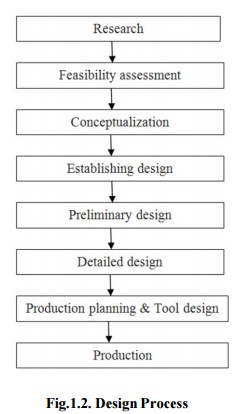Chapter: Mechanical : Computer Aided Design : Fundamentals of Computer Graphics
Design Process
Design Process
The design process includes series of steps that engineers apply in making functional products and processes. The parts of the process often need to be repeated many times before production of a product can start. The parts that get iterated and the number of such design cycles in any given project can be highly changeable.
One method of the engineering design process focuses on the following common aspects:

Fig.1.2. Design Process
1. Research
A considerable amount of time is used on research, or finding information. Consideration should be given to the available applicable literature, issues and successes linked with avaialbe solutions, and need of marketplaces.
The basis of information should be significant, including existing results. Reverse engineering can be a successful technique if other solutions are available in the market. Added sources of information include the trade journals, available government documents, local libraries, vendor catalogs and personal organizations.
2. Feasibility assessment
The feasibility study is an analysis and assessment of the possible of a proposed design which is based on detail investigation and research to maintain the process of decision creation. The feasibility assessment helps to focus the scope of the project to spot the best situation. The purpose of a feasibility assessment is to verify whether the project can continue into the design phase.
3. Conceptualization
A Concept Study is the stage of project planning that includes developing ideas and taking into account the all features of executing those ideas. This stage of a project is done to reduce the likelihood of assess risks, error and evaluate the potential success of the planned project.
4. Establishing the design requirements
Establishing design requirements is one of the most essential elements in the design practice, and this task is usually performed at the same time as the feasibility analysis. The design requirements control the design of the project all over the engineering design process. A few design
requirements comprise maintainability, hardware and software parameters, availability, and testability.
5. Preliminary design
The preliminary design fills the gap between the design concept and the detailed design phase. During this task, the system configuration is defined, and schematics, diagrams, and layouts of the
project will offer early project configuration. In detailed design and optimization, the parameters of the part being produced will change, but the preliminary design focuses on creating the common framework to construct the project.
6. Detailed design
The next phase of preliminary design is the Detailed Design which may includes of procurement also. This phase builds on the already developed preliminary design, aiming to further
develop each phase of the project by total description through drawings, modeling as well as specifications.
The advancement CAD programs have made the detailed design phase more competent. This is because a CAD program can offer optimization, where it can shrink volume without compromising the part's quality. It can also calculate displacement and stress using the FEM to find stresses throughout the part. It is the responsibility of designer to find whether these stresses and displacements are acceptable, so the part is safe.
7. Production planning and tool design
The production planning and tool design is more than planning how to mass-produce the project and which tools should be used in the manufacturing of the component. Tasks to complete in this stage include material selection, identification of the production processes, finalization of the sequence of operations, and selection of jigs, fixtures, and tooling. This stage also includes testing a working prototype to confirm the created part meets qualification standards.
With the finishing of qualification testing and prototype testing, the design process is completed.
Related Topics